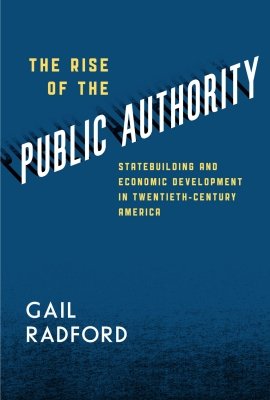Gail Radford
Former Fellow
Professional Affiliation
Associate Professor, Department of History, State University of New York at Buffalo
Expert Bio
As a graduate student in history at Columbia University, my primary focus was 20th century U.S. urban history. I came into that field partly out of a love for cities, but also because I wanted to understand how Americans have made decisions about building social infrastructure—both in terms of design and levels of funding. In essence, I wondered why in the U.S. it was so hard to do coherent urban and regional planning, and to deal with housing issues in a way that would banish homelessness. And I was dissatisfied, even then, with answers relying on the assertion that Americans were ideologically or emotionally wedded, in some deep and irreversible way, to our present patterns. I was more persuaded by approaches stressing political economy and the impact of social movements and pressure groups working for or against change in public policy.These interests came together in my doctoral dissertation, out of which developed my first book, Modern Housing for America: Policy Struggles in the New Deal Era. In this work I traced the development of federal housing policy in the 1920s and 1930s, starting with the economics of the housing industry in the early 20th century and the resulting housing conditions.Several aspects of my work on housing policy pushed me in the direction I am currently pursuing. The first was observing the ways in which economic pressures put otherwise contending forces—business groups and left-of-center reformers—onto somewhat parallel tracks in advocating government economic activism. It became apparent that such activism was not just a liberal or progressive agenda. I began to notice that the ways government activism was structured institutionally was as significant as its putative goals. Also, I became increasingly aware of the relative invisibility of much government action in the U.S., particularly that carried out by the numerous administratively independent, self-funding agencies that have been created by all levels of government in all parts of the country. In short, I became persuaded that the techniques of public activism in themselves deserved more investigation, and this conviction has governed my research since then. This new line of research has led to several conference papers and two articles, tracing the early 20th century origins of agencies that could engage directly in the economy to pursue public goals. During my fellowship year I will be working on a book manuscript that describes the variety of trial-and-error efforts in the early 20th century to construct workable institutional mechanisms within existing constitutional and statutory frameworks. The book will explain how these streams of innovation came together during the crisis of the Great Depression to result in the durable and popular template for quasi-public agencies that continues to be widely used today. Methodologically, within the field of U.S. political history, this work argues for a shift from an almost exclusive concentration on political culture, parties, and elections, to more engagement with how and why state activity changes over time, and how it influences people's lives and ideas. I am striving to introduce into standard historical accounts of political change a greater appreciation of the way laws and government-created institutions define the "rules of the game" in which individuals and groups operate—while not losing sight of the story of how particular political actors and social movements try to modify the context they inherit. Beyond academic concerns, the book will consider the policy implications (some of them unintended) of the line of institutional development it analyzes. American-style public enterprise has often resulted in efficiency and ability to do long-term planning. At the same time, quasi-public agencies are often insulated from democratic accountability; they do little, because of their invisibility, to build support or constituencies for positive government; and they are limited in the purposes they can serve by their near-total reliance on revenues and bonds. In effect, the policy implication is that as a nation the U.S. could benefit from experimenting with other modes of public activity in the economic realm. The fact that our current form of activism results less from core American values or elite purposes than from ad-hoc tactics adopted in the face of institutional obstacles—and the side-effects of those tactics—gives cause for hope that other forms are possible.
Education
B.A. (1967) History, University of California at Santa Barbara; M.A. (1979) History, Columbia University; Ph.D. (1989) History, Columbia University
Subjects
U.S. History,Urban Issues
Experience
- Associate Professor of History, State University of New York at Buffalo, 1999 to present
- Assistant Professor of History, State University of New York at Buffalo, 1993-99
- Visiting Assistant Professor of History, Carroll College, 1991-92
- Charles Phelps Taft Postdoctoral Fellow, University of Cincinnati, 1990-91
Expertise
History of U.S. domestic public policy, especially housing policy; historical development of quasi-public agencies such as public authorities; urban and planning history; progressive, 1920s, and New Deal era politics and political economy
Wilson Center Project
The American Way of Public Enterprise
Project Summary
This project explores the historical development of a significant, but largely invisible and under-researched sphere of the U.S. state: the quasi-governmental agencies through which American government engages in economic activity. These mechanisms—special districts, public authorities, public corporations, and the like—function quite independently, although they are launched by general-purpose governments to fulfill public purposes. They constitute the fastest growing sector of American government, by now accounting for a larger proportion of state and local borrowing than general-purpose units. Substantively, the project studies the origins and growth of this sector since its beginnings in the early 20th century, and its implications for public policy and the trajectory of American politics since then. Methodologically, the project seeks to encourage more attention within political history to the institutional environment within which political activity takes place.
Major Publications
- The Rise of the Public Authority: Statebuilding and Economic Development in Twentieth-Century America (University of Chicago Press, 2013), Winner of The Kenneth Jackson Award from the Urban History Association for the best book in North American Urban History in 2013
- "From Municipal Socialism to Public Authorities: Institutional Factors in the Shaping of American Public Enterprise," Journal of American History, 90 (December 2003): 863-90
- "William Gibbs McAdoo, the Emergency Fleet Corporation, and the Origins of the Public-Authority Model of Government Action," Journal of Policy History 11 (1999): 59-88
- Modern Housing for America: Policy Struggles in the New Deal Era (University of Chicago Press, 1996)
Insight & Analysis by Gail Radford
- Book
The Rise of the Public Authority: Statebuilding and Economic Development in Twentieth-Century America


